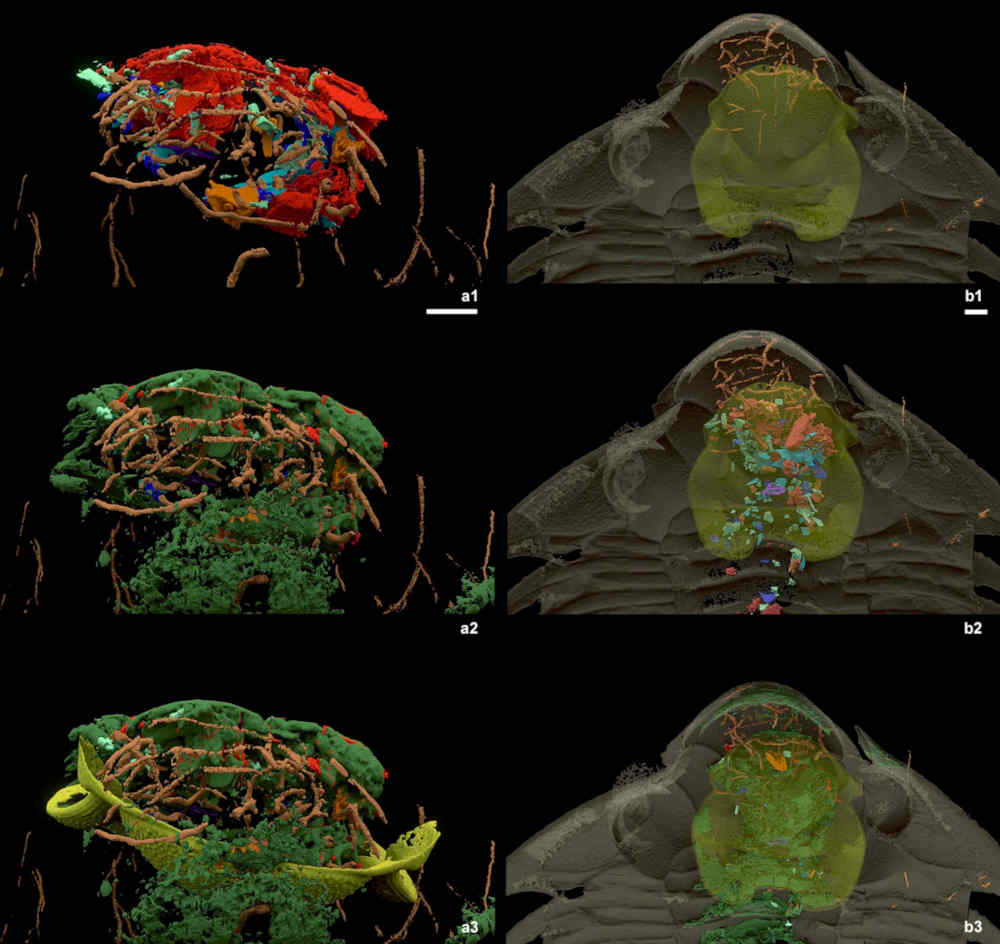Paleontology News

Illustration of the Bohemolichas trilobite scavenging on the sea floor before it was buried. Image Credit: Jiri Svoboda
Unearthing Trilobite Secrets: Remarkable preservation shows the remains of a trilobite meal.
Using advanced imaging, the first gut contents of a trilobite have been revealed.
Summary Points

Figure 1 from Kraft et al., 2023 - Nature showing the (a) Bohemolichas incola specimen and (b-d) models of the specimen with the gut contents highlighted in red and blue.
The diets of Trilobites, ancient marine creatures for over 270 million years, have only been inferred
by their morphology, until now.
The Cambrian trilobite, Bohemolichas incola, was found with preserved gut contents.
Using synchrotron microtomography, researchers uncovered a detailed 3D view of the trilobite's digestive tract, confirming various invertebrate shell fragments.
As suspected, Bohemolichas incola, was a scavanger, eating bits of material off teh sea floor.
Undissolved shell fragments suggest a neutral or alkaline digestive environment, resembling modern crustaceans.
Tiny burrows in the trilobite reveal scavenger activity after death.
Unearthing Trilobite Secrets: Remarkable preservation shows the remains of a trilobite meal.
This article is based on a new release by Charles University - September 27, 2023, and the Open Access (CC BY 4.0) Journal Article (Kraft et al, 2023) from Nature.
Trilobites, enduring icons of marine ecosystems for over 270 million years, from the Cambrian to the Permian, have left a permanent mark on the fossil record. With a staggering discovery of over 20,000 species, they stand as cherished relics of our ancient seas. Despite their prevalence, understanding their ecological roles has primarily relied on interpretations drawn from their intricate body structures. Their varied morphologies hint at potential ecological roles: some suggest a life of filter-feeding in the open water, others imply a predatory existence on the seafloor, while many point towards an existence as a scavenger. Due to the inherent limitations of fossils, there has never been direct evidence of the exact nature of their diets until now.
Recently, faculty members from Charles University in Prague, along with their colleagues, described a remarkable Cambrian trilobite known as Bohemolichas incola. Discovered in 1908 in the Czech Republic, this specimen has been housed at the Museum of West Bohemia for well over a century. This fossil holds a unique feature – minuscule shell fragments visible in a peeled-off section of the axial lobe. Paleontologists speculated these fragments might harbor preserved digestive tract contents. However, it was impossible to further study these features without permanently damaging the fossil. However, recently, the team has harnessed a cutting-edge method known as synchrotron microtomography to meticulously scrutinize the shells. This revolutionary imaging technique provides intricately detailed 3D sliced images, akin to a CT scan.
Based on this analysis, they successfully confirmed the debris constituted the preserved remnants of the trilobite's digestive tract. Within it, they uncovered an assortment of shell fragments originating from various invertebrate species, including ostracods, bivalves, and echinoderms. This revelation led the authors to posit that the trilobite operated as an opportunistic scavenger, consuming any debris on the seafloor—whether alive or dead — provided it was small enough to be ingested whole and was easily digestible.
The presence of undissolved shell fragments suggests that the trilobite's intestinal tract likely maintained a neutral or alkaline environment, similar to modern-day crustaceans. Additionally, a fascinating discovery came in the form of numerous minuscule burrows found within the trilobite. These were created by scavengers that had tunneled into and fed on the dead trilobite. Notably, these scavengers stayed away from the gut region, implying potential ongoing enzymatic activity within the digestive tract even after the trilobite's death.

Figure 2 from Kraft et al., 2023 - Nature showing the Digestive tract content composition. (a,b) are the full digestive tract infill. (C) are stylophoran echinoderm plates, (d) are hyolith pieces, and (e) are ostracod shells. Scale bars, 1 mm (a,b), 500 �m (c�e).

Figure 9 from Kraft et al., 2023 - Nature showing Associated trace fossils of scavengers in the head region. The trace fossils are in brown.
Journal Article:
Kraft, P., Vaškaninová, V., Mergl, M. et al. Uniquely preserved gut contents illuminate trilobite palaeophysiology. Nature (2023). DOI: 10.1038/s41586-023-06567-7
Recommended Trilobite Books and Fossils
Trilobites for Sale:

Trilobites from Fossil Era
Trilobite fossils are some of the most beautiful and collectible fossils in the world!
There are countless species of trilobites. They make beautiful display and conversation pieces.
Common ones make very affordable for gifts to fossil and paleontology enthusiasts.
Fossil Era has a huge selection of top quality trilobites from many states and many countries. It's fun just to browse through the inventory and look at all the different types!














